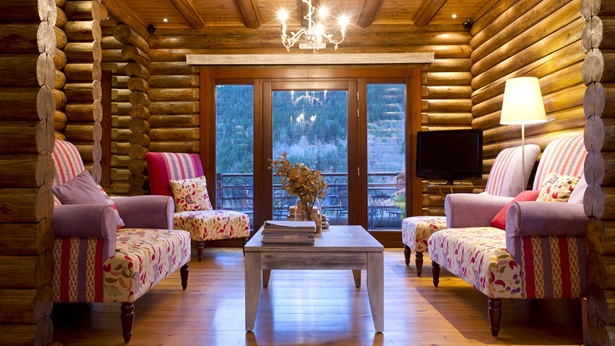How to Choose a Log Home Producer
At first glance, deciding on which log and timber home company to entrust your dreams with seems easy as rolling off a log. Choose a company that owns a large forest and you’ve got yourself the lowest priced log and timber home. Right?
Unfortunately, just like life, it’s a little more complicated than that. But that’s why the Log and Timber Homes Council created The Perfect Path to Your Dream Home, to help consumers make educated decisions about what is likely one of the greatest investments in their lives.
Where Do You Start?
Limit your choices to the companies that belong to the Log and Timber Homes Council, which is part of the National Association of Home Builders. The council has adopted membership requirements that protect consumers during the buying and building process.
Use This Website
To start shopping for log and timber home producers, use this listing of all log and timber home manufacturers that belong to the council. On this pages you will find company profiles, photos and links to their websites.
Attend a Home Show
Visit with exhibitors and obtain their brochures, plan books, catalogs, DVDs and CDs. As you proceed in your research, note a council member’s dedication to meeting your needs. Since you are investing your life savings in this project, expect a level of service from the log and timber home company that reflects the importance of this decision.
Tour Manufacturing Facilities
Don’t judge a company only by its website. A visit to the manufacturing or crafting facilities will give you a feel for a company’s people, pride in its work and its approach to customer service. Because you’ll likely spend some time with them making your dream a reality, it helps if you get along on a personal level.
Tour Completed Homes
Homes that are four or five years old are a best example of a manufacturer’s building system, as well as the local builder’s craftsmanship that turnkeyed the home.
Focus on the Style You Like
The process of elimination should start with what you find attractive. Just to recap, your choices include:
- Manufactured: Logs are milled to a specific profile (D-log, round log, square or rectangular). Identify these by the uniform diameters on the corner profiles.
- Half-log: This involves half log siding applied inside and outside the home. Often used for second story, garage and dormers of a full-log and timber home. Corner sections can be full log, to maintain the illusion.
- Handcrafted: Detect these by noticing larger logs with varying diameters at corners or a hand-hewn appearance.
- Post and Beam: Also known as timber frame, this style includes large horizontal or vertical beams on the interior. Beams can either be handcrafted or milled.
Diving into the Details
There are different tree species, drying techniques and fastening systems. To wade into the buying process with confidence, you’ll need to grasp the industry’s terminology.
Log Moisture Content
The amount of moisture in logs affects a host of issues, including construction technique, fastening and sealant strategies. There are five common approaches to log material usage and preparation:
- Green logs: Have a great deal of moisture content. Meaning these are logs that are used within a short time after harvesting the tree.
- Air-dried logs: Commonly dried for six months to two years while stored in a log yard.
- Partially kiln-dried logs: The outside of the log [or cant] is dried for a period of time, typically to destroy insects and their larvae, as well as eliminate mold and mildew.
- Fully kiln-dried logs: The whole log [or cant] is dried to around 18% moisture content.
- Standing dead timber: Often killed by insect predation or forest fire, these trees are harvested and can be then dried further in log yards or kilns.
Settlement Strategy
Many companies that fully kiln-dry their logs, say that no settlement strategy is needed in construction. But for those that use green or partially kiln-dried logs, some settlement strategy will likely be needed during construction. Log home producers account for this settlement in different ways, such as creating settling space around windows, doors, stairwells and vertical posts. Ask your prospective log and timber home council members how their building system compensates for settlement.
What’s in the ‘Log Home Package?’
Each council member has their own definition of a “log and timber home package,” the building materials that will create your dream home. One manufacturer may offer a load of random length logs, which have to be cut on the building site to fit the home’s design. Another may offer a precut, pre-notched and pre-numbered package along with all the materials needed to complete a weather-tight shell. Log home council members are fully aware how difficult it can be for consumers to compare and contrast the completeness of various home packages. This is why many council members list their package materials they provide on their websites, as well as any upgrades, including interior walls, floors, cabinets, hardware, windows, doors and more.
Payment Policies
Preliminary design work and quotes for log and timber home packages are provided for free or at little cost. Most companies require a deposit before the company starts creating custom construction drawings, to defray design and engineering costs. Partial payments are usually required before a log package is cut to a specific home’s design, with the balance upon delivery of the package to the job site.
Who is Constructing the Home?
A few members of the Log and Timber Homes Council offer full “turnkey” construction. Others may offer “shell construction,” where the home is made weather-tight but interior finishes are left to other contractors. An even greater number of council members leave it to independent builders or contractors to complete the home on your land. If the producer recommends certain builders in your area, discover if they are available for your timetable to build. The key to a quality home is often in how it’s finished at the job site. This means it is important to choose a builder who is familiar with a manufacturer’s building system — or who is willing to follow detailed instructions.
Not a Bottom-Line Decision
Don’t just make your decision on package price alone, home buyers and veteran log and timber home builders say. Also compare quality, quantity and service.
- Quality: How much pre-cutting is done by the manufacturer? What grade are a company’s logs or timbers? What is their moisture content? How will this affect the amount of settling that occurs?
- Quantity: This quantity refers to the amount of materials contained in a producer’s log and timber home package and how much materials you will need to obtain locally.
- Service: An 800 number to ask advice before, during and after construction is included in the purchase price by some companies. Others charge for this service on a per hour basis.
Don’t Make Yourself Crazy Over This Decision
Many buyers set out to discover which company among the Log and Timber Homes Council has the best tree species or building system on the market. After months or years of diligent research, these consumers report they often end up more confused than when they started. Truth is, there isn’t a single best species or system of construction. If there were, every company would be using the same one. Our advice is to put your energy into creating the perfect design for your lifestyle and building site. Then have several companies competitively bid on your project that offer your favorite log species, profile and corner style.



